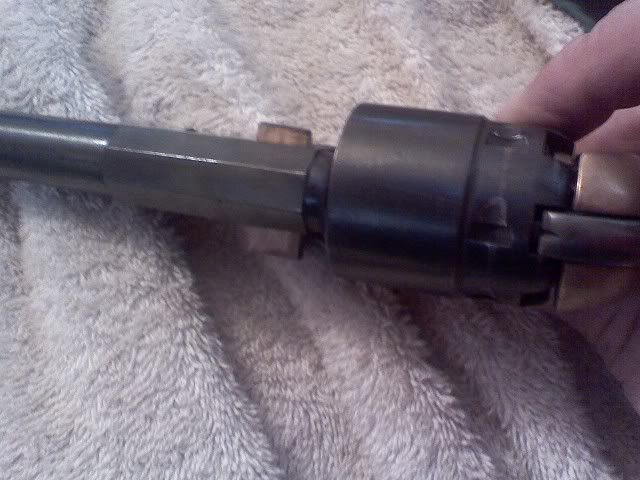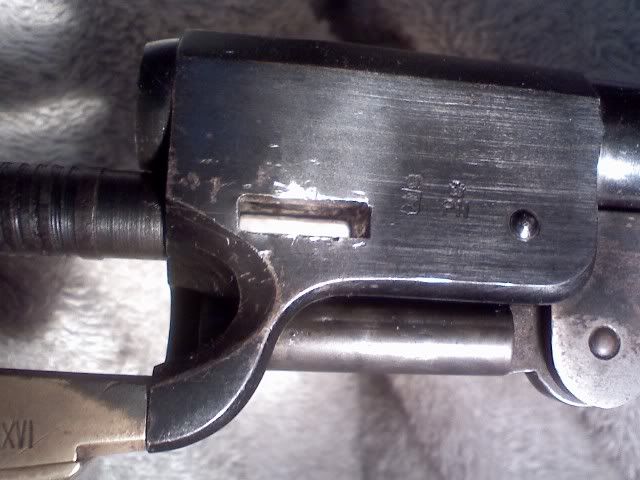You are using an out of date browser. It may not display this or other websites correctly.
You should upgrade or use an alternative browser.
You should upgrade or use an alternative browser.
Getting a free Uberti ...needs work
- Thread starter Delmar
- Start date
OK I shot the Colt today. Here is a video of me trying to shoot gunfighter style with the Colt and the Euroarms Remie.
http://s901.photobucket.com/albums/ac214/deardelmar/?action=view¤t=shoot.flv
I was having a little trouble with the caps fitting correctly. I guess I should have worked that out before I tried shooting with both hands. Also the plastic bullets don't seat as tight in the Colt as they do in the Remies, and one of them came unseated and shut me down. I guess I'm going to need to paper patch them for the Colt.
I'm not sure if I'm ever going to get to shoot real lead balls in the Colt. The wedge I ordered for it was to small. The Gal at VTI gun parts says if that one doesn't fit the only thing I can do is buy one for a Walker and "whittle it down". In the mean time I made one out of a piece of Maple. It works fine for shooting plastic bullets, but I'm not sure it would hold up to the recoil of even a light load with real lead.

http://s901.photobucket.com/albums/ac214/deardelmar/?action=view¤t=shoot.flv
I was having a little trouble with the caps fitting correctly. I guess I should have worked that out before I tried shooting with both hands. Also the plastic bullets don't seat as tight in the Colt as they do in the Remies, and one of them came unseated and shut me down. I guess I'm going to need to paper patch them for the Colt.
I'm not sure if I'm ever going to get to shoot real lead balls in the Colt. The wedge I ordered for it was to small. The Gal at VTI gun parts says if that one doesn't fit the only thing I can do is buy one for a Walker and "whittle it down". In the mean time I made one out of a piece of Maple. It works fine for shooting plastic bullets, but I'm not sure it would hold up to the recoil of even a light load with real lead.

sundance44s
New member
That gun has a woodie !
update
I took the gun to a fiend of mine who is a machinist and he got the pin out for me and threaded the hole for a set screw. I couldn't believe how much it tightened up the arbor. The wiggle is gone entirely!The arbor will not come out with this pin in place.
madcratebuilder
New member
Doc, the pin is normally drilled half in the arbor, half in the frame. If you drill that pin out and then thread it you can use a setscrew when it goes back together. That well tighten up a loose arbor sometimes. Use a tap that has a good taper to it and don't use a bottom tap. You want the setscrew to be a interference fit as it bottoms out.
MCB
So you are saying that the set screw is installed in the same orientation as the original pin? Hole enlarged from the back of the pistol and then threaded which makes a lot of sense although it seems like a ticklish operation given the dissimilarities between steel (arbor) and brass (frame).
I pictured the set screw hole drilled perpendicular to the axis of the arbor.
If you drill down through the frame at a position which is underneath the hammer, the operation would remove a lot of metal from the frame and potentially weaken the frame at a point where there is not much metal in the first place. An alternate would be to drill in from the right side of the frame and catch the arbor that way. The problem here is that the set screw would be visible from the right side of the pistol. That would be unacceptible to some shooters. (I suppose it would be better than a loose arbor.) Drilling up from the underside of the frame would present much the same problem as drilling down. Not much metal under there. You can't drill from the left side of the pistol because of the interference created by the hand.
So you are saying that the set screw is installed in the same orientation as the original pin? Hole enlarged from the back of the pistol and then threaded which makes a lot of sense although it seems like a ticklish operation given the dissimilarities between steel (arbor) and brass (frame).
I pictured the set screw hole drilled perpendicular to the axis of the arbor.
If you drill down through the frame at a position which is underneath the hammer, the operation would remove a lot of metal from the frame and potentially weaken the frame at a point where there is not much metal in the first place. An alternate would be to drill in from the right side of the frame and catch the arbor that way. The problem here is that the set screw would be visible from the right side of the pistol. That would be unacceptible to some shooters. (I suppose it would be better than a loose arbor.) Drilling up from the underside of the frame would present much the same problem as drilling down. Not much metal under there. You can't drill from the left side of the pistol because of the interference created by the hand.
Exactly right
Del,
I agree with you about three hundred percent. In fact I have always thought that the pin design is a little on the "Rube Goldberg" side. I don't know if originals came with the pin. But had I been a manufacturer concerned with keeping the arbor tight and axially alligned I think I would have drilled all the way through from top to bottom and through the arbor. I would have driven the pin into the frame. With the hole drilled all the way through the frame, the pin could be driven out easily if necessary. I do acknowledge that drilling the frame as I have described might weaken the frame.
I doubt that the manufacturers were much worried about arbors coming loose. I think their attitude was probably more like, once the pistol is out the door, the government will assme full responsibility for dealing with the failures.
Here is a question for you historians:
Isn't it true that most of the brass frame revolvers that were copied from the Colt open top design, were made in the South and were made during the war, not before the war? Did Colt manufacture any brass frame pistols in the 1851 or 1860 pattern?
Del,
I agree with you about three hundred percent. In fact I have always thought that the pin design is a little on the "Rube Goldberg" side. I don't know if originals came with the pin. But had I been a manufacturer concerned with keeping the arbor tight and axially alligned I think I would have drilled all the way through from top to bottom and through the arbor. I would have driven the pin into the frame. With the hole drilled all the way through the frame, the pin could be driven out easily if necessary. I do acknowledge that drilling the frame as I have described might weaken the frame.
I doubt that the manufacturers were much worried about arbors coming loose. I think their attitude was probably more like, once the pistol is out the door, the government will assme full responsibility for dealing with the failures.
Here is a question for you historians:
Isn't it true that most of the brass frame revolvers that were copied from the Colt open top design, were made in the South and were made during the war, not before the war? Did Colt manufacture any brass frame pistols in the 1851 or 1860 pattern?
Isn't it true that most of the brass frame revolvers that were copied from the Colt open top design, were made in the South and were made during the war, not before the war? Did Colt manufacture any brass frame pistols in the 1851 or 1860 pattern?
Yes it's true altho they weren't exactly brass but gunmetal which is a form of bronze with a high copper content. There is a Colt model 60 prototype in brass with a Mershon & Hollingsworth cocking system but it was never put into production.
Goatwhiskers
New member
IF the cylinder arbor is threaded in place but loose, there is a thread restorer product available from Brownells. I only used it once on a screw and it seemed to work quite well--might be worth a try. A little easier than soldering. Goatwhiskers the Elder

